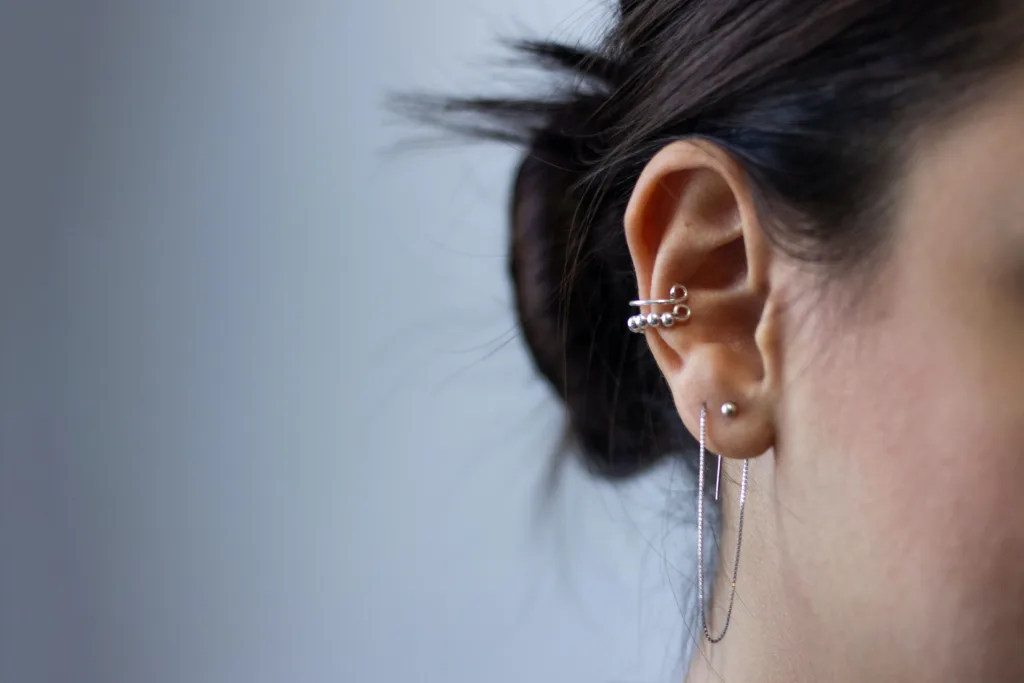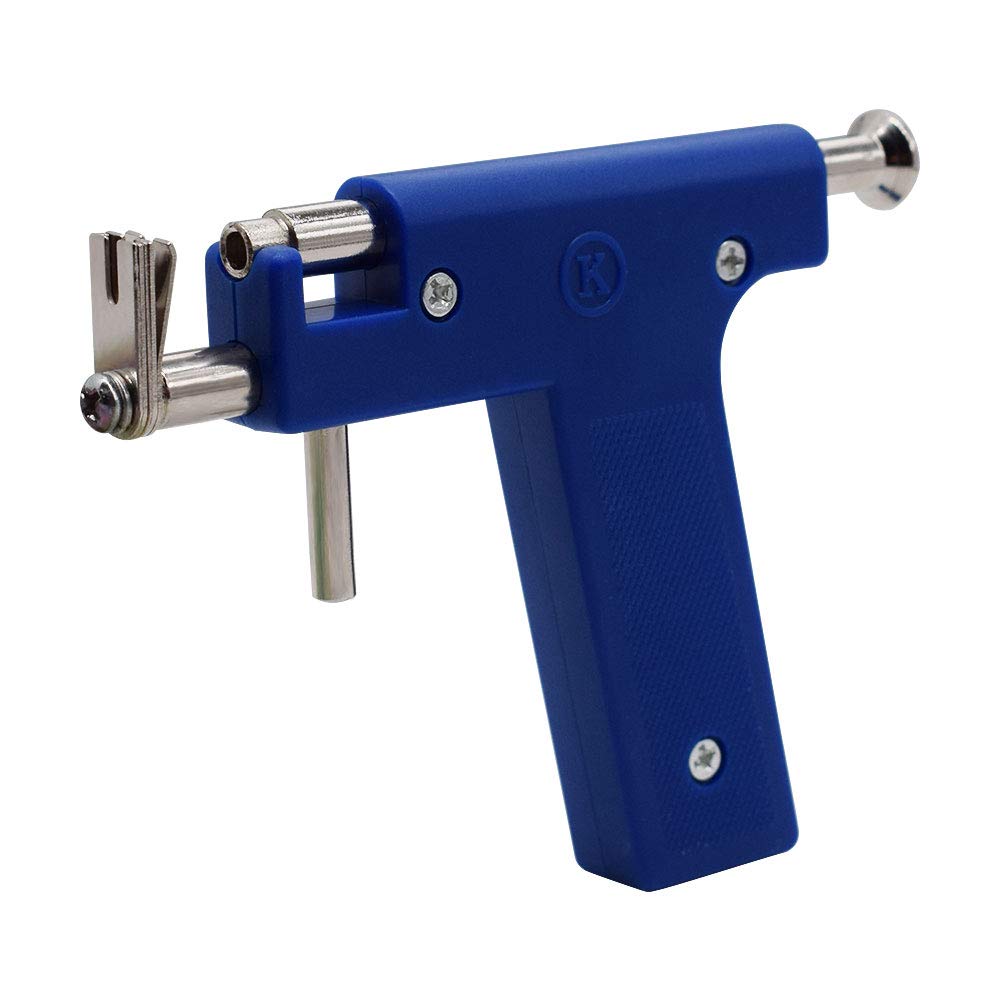Piercing guns have long been a popular choice for many people seeking a quick and inexpensive way to get their ears or other body parts pierced. However, it is important to understand that these guns can cause significant tissue damage and pose potential risks to your health.
One of the main issues with piercing guns is the fact that they create blunt force trauma. When the gun is used to forcefully push a stud through the skin, it can result in significant pain, swelling, and trauma to the surrounding tissue. This can lead to longer healing times and potentially increased risks of complications such as scarring or auricular chondritis, a severe tissue disfigurement.
In contrast, piercing needles offer a much safer and more hygienic option for body piercing. Needles create less tissue trauma, resulting in shorter healing times and less discomfort for the client. Additionally, needles allow for a more precise piercing angle, ensuring that the piercing is done accurately and aesthetically pleasing.
Another important aspect to consider is the risk of infection. Any object that is purposefully introduced through the skin should be sterile to minimize the chances of infection. Piercing guns, unfortunately, often lack the necessary sterilization procedures, increasing the risk of contamination and potential infections.
Additionally, the excessive swelling caused by the blunt force of a piercing gun can lead to further complications. The jewelry used in gun piercings is typically too short to accommodate the swelling and increased blood flow that occurs during the healing process. This can result in discomfort, restricted movement, and potential issues with the healing of the piercing.
While piercing guns may seem like a convenient and cost-effective option, they come with significant risks to your health. The blunt force trauma they cause can result in pain, swelling, and potential tissue disfigurement. Needles, on the other hand, offer a safer and more precise piercing experience with shorter healing times and less risk of complications. It is important to prioritize your health and choose a professional piercer who uses needles for a safe and hygienic piercing experience.
Why Should You Not Use A Piercing Gun?
There are several reasons why using a piercing gun is not recommended:
1. Tissue Damage: Piercing guns use a spring-loaded mechanism to forcefully push a stud through the skin. This can cause significant tissue damage due to the blunt force trauma inflicted on the area. The forceful nature of the procedure can lead to pain, swelling, and potential tearing of the skin.
2. Increased Risk of Infection: The design of piercing guns makes it difficult to properly sterilize them. This increases the risk of introducing bacteria into the piercing site, which can lead to infections. Infections can cause complications, such as prolonged healing time, scarring, and in severe cases, the need for medical intervention.
3. Inaccurate Placement: Piercing guns lack precision when it comes to placing the jewelry. They rely on a pre-loaded stud, which may not be suitable for all types of piercings or anatomical variations. This can result in an inaccurate piercing placement, potentially causing discomfort or aesthetic dissatisfaction.
4. Potential for Auricular Chondritis: Auricular chondritis is a severe tissue disfigurement that can occur as a result of using piercing guns. The excessive force applied by the gun can damage the cartilage in the ear, leading to inflammation and deformity. This condition is often difficult to treat and may require surgical intervention.
5. Limited Jewelry Options: Piercing guns typically use studs with butterfly backs, which are not suitable for long-term wear. This limits the jewelry options available to the client, as they may not be able to choose from a wide range of high-quality jewelry materials and designs.
6. Lack of Professionalism: Piercing guns are commonly used by non-professionals, such as mall kiosks or inexperienced individuals. These individuals may not have the proper training or knowledge to perform piercings safely. Choosing a professional piercer who uses sterile equipment and follows proper hygiene protocols ensures a better overall piercing experience.
It is important to prioritize your safety and well-being when considering any type of body piercing. Opting for professional piercing services using sterile needles and proper techniques can help minimize the risks associated with piercing guns.

Why Are Piercing Guns Worse Than Needles?
Piercing guns are considered worse than needles for several reasons:
1. Tissue Trauma: Piercing guns work by forcefully pushing a stud or earring through the skin, causing more trauma to the tissue compared to needles. The forceful nature of the gun can lead to excessive pressure, tearing, and damage to the surrounding tissue.
2. Healing Time: Due to the increased tissue trauma, piercings done with guns often take longer to heal. The healing process may be prolonged and more complicated, leading to a higher risk of infection and other complications.
3. Hygiene: Piercing guns are difficult to sterilize completely, increasing the risk of infection. The reusable parts of the gun, such as the plastic cartridge and the earring holder, can harbor bacteria and pathogens even after cleaning. Needles, on the other hand, are single-use and disposed of after each piercing, minimizing the risk of contamination.
4. Precise Piercing Angle: Piercing guns have limited flexibility in terms of piercing angle. This can result in inaccurate placement or an uneven piercing, which may not be aesthetically pleasing or comfortable for the wearer. Needles, on the other hand, allow piercers to have better control over the angle, ensuring a more accurate and desired placement.
5. Jewelry Options: Piercing guns are often limited to using pre-packaged studs or earrings, which may not be of the highest quality or suitable for all individuals. Needles offer more flexibility, allowing for a wider range of jewelry options to choose from, including different gauges, lengths, and materials.
6. Professional Training: The use of piercing guns does not require extensive training or expertise. This can lead to inexperienced individuals performing piercings, increasing the risk of complications. Professional piercers who use needles undergo specialized training and certification, ensuring a higher level of skill and knowledge.
7. Legal Restrictions: In some areas, the use of piercing guns may be restricted or prohibited due to the associated risks and potential harm they can cause. Needles, being the preferred method in professional piercing studios, are generally accepted and regulated by health and safety standards.
Piercing guns are considered worse than needles due to the increased tissue trauma, longer healing time, hygiene concerns, limited flexibility in piercing angle, limited jewelry options, lack of professional training required, legal restrictions, and overall higher risk of complications.
Are Piercing Guns Good Or Bad?
Piercing guns are generally considered to be bad for several reasons. Here are some key points to consider:
1. Increased risk of infection: Piercing guns are not designed to be sterile, which increases the likelihood of infection. Any object that is intentionally inserted into the skin should be sterile to minimize the risk of infection.
2. Inaccurate placement: Piercing guns may not provide precise control over the placement of the piercing. This can result in uneven or misplaced piercings, which may be difficult to correct.
3. Tissue damage: The force used by piercing guns can cause unnecessary trauma to the surrounding tissue. This can lead to prolonged healing times and increased discomfort.
4. Limited jewelry options: Piercing guns typically use pre-loaded studs, limiting the jewelry options available for your piercing. This can be a drawback if you prefer more diverse or customized jewelry options.
5. Inadequate aftercare guidance: Piercing guns are often used by untrained individuals who may not provide proper aftercare instructions. This lack of guidance can increase the risk of complications and slow down the healing process.
Considering these factors, it is generally recommended to opt for professional piercing services that use sterile equipment and provide knowledgeable aftercare instructions. This ensures a safer and more successful piercing experience.
Why Is A Earring Gun Bad?
There are several reasons why a earring gun is considered bad:
1. Blunt pressure and trauma: Earring guns use blunt pressure to force the earring stud through the tissue. This can cause excessive trauma and swelling to the pierced area, leading to increased pain and discomfort compared to needle piercing.
2. Insufficient room for swelling: Due to the excessive swelling caused by the blunt force, the jewelry used in earring guns is often too short. This lack of adequate room for swelling can lead to complications such as irritation, infection, and prolonged healing time.
3. Increased risk of infection: The use of earring guns increases the risk of infection compared to needle piercing. The combination of the trauma caused by the gun and the improper jewelry can create an ideal environment for bacteria to thrive, increasing the likelihood of infection.
4. Limited control and precision: Earring guns do not offer the same level of control and precision as needle piercing. The forceful nature of the gun can lead to uneven piercings, causing asymmetry or other aesthetic issues.
5. Restricted choice of jewelry: Earring guns often limit the choice of jewelry that can be used. The studs used with earring guns are typically pre-packaged and may not be of high quality or suitable for individuals with metal sensitivities.
6. Professional expertise: Earring guns are commonly used by non-professionals, such as retail store employees, who may not have the necessary training and expertise in proper piercing techniques. This lack of professional knowledge and experience increases the risk of complications and improper aftercare guidance.
It is important to note that these reasons apply to the use of earring guns in any setting, and it is generally recommended to opt for needle piercing performed by a professional piercer to minimize potential risks and ensure a safe and successful piercing experience.

Conclusion
The use of piercing guns should be avoided due to the significant tissue damage and potential health risks they pose. While they may be fast and cheap, they can result in blunt force trauma, causing pain, swelling, and potentially scarring or disfigurement. In contrast, piercing with needles is a more hygienic and precise method, resulting in less tissue trauma, shorter healing time, and a reduced risk of infection. It is important to prioritize the sterility of any object introduced through the skin to minimize the probability of infection. Additionally, the excessive swelling caused by piercing guns often leads to the use of inadequate jewelry, which can further complicate the healing process. opting for needle piercings is the safer and more beneficial choice for those considering body piercings.
